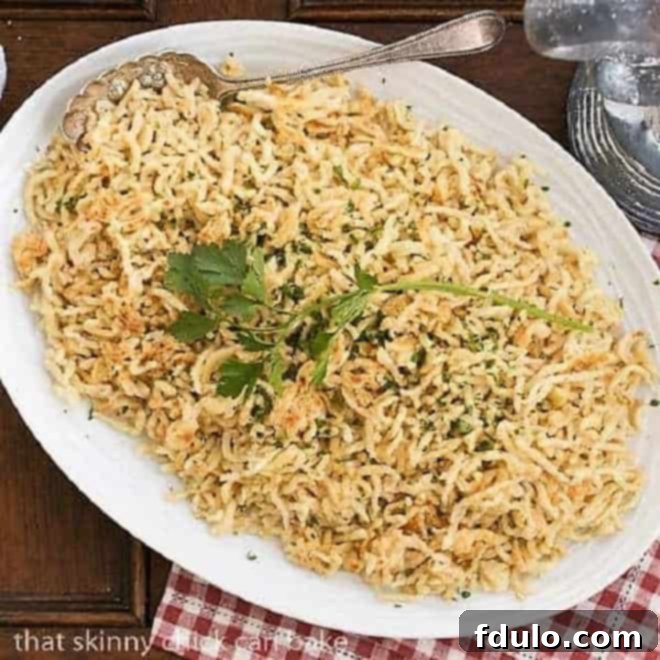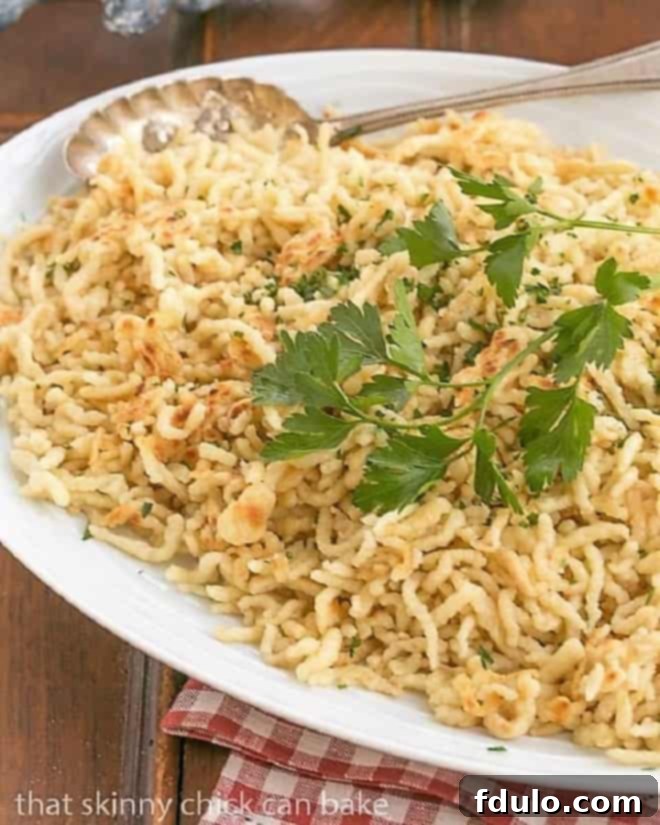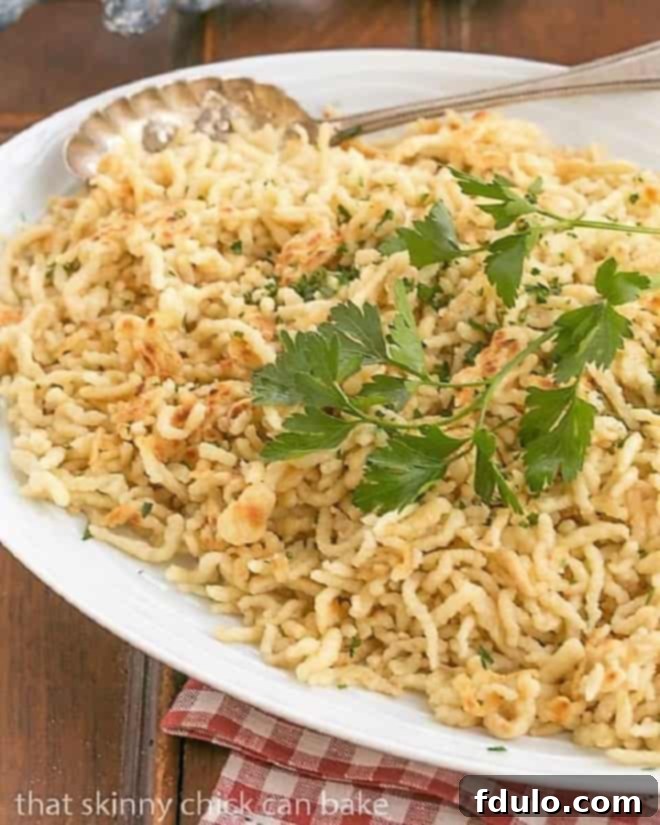Spaetzle is a beloved German egg noodle, renowned for its delicate texture and versatile nature. This simple yet satisfying dish offers a delightful alternative to common sides like potatoes or rice, making it a perfect addition to a wide array of meals. Learning how to make spaetzle from scratch is surprisingly easy, transforming basic kitchen staples into a culinary masterpiece.
Our comprehensive guide simplifies the process of creating authentic German spaetzle. Made with just four fundamental ingredients, this spaetzle recipe promises a delicious and wholesome side that complements almost any main course. Prepare to impress your family and friends with this classic European comfort food.

Why You Need to Try This Homemade Spaetzle Recipe
Embarking on the journey of making homemade spaetzle is an incredibly rewarding experience, offering numerous advantages over store-bought alternatives. This isn’t just about cooking; it’s about embracing a tradition and savoring flavors that are genuinely unparalleled.
- Unmatched Flavor and Texture: While convenient, pre-packaged noodles simply cannot replicate the fresh, chewy, and slightly crispy texture of homemade spaetzle. The moment you taste your own freshly made German egg noodles, you’ll understand why this recipe is a game-changer. The subtle nuances in flavor, along with the perfect al dente bite, elevate any meal.
- Simple, Wholesome Ingredients: You’ll be amazed that such a delectable dish can be created from ingredients you likely already have in your pantry. Flour, eggs, water, and salt are the humble building blocks of this extraordinary noodle. This simplicity means you’re always just minutes away from whipping up a batch of delicious, wholesome spaetzle without needing a special grocery trip.
- A Rewarding Culinary Experience: You don’t necessarily need a specialized spaetzle maker to begin your journey, though many who discover the joy of these German egg noodles find it a worthwhile investment. The process of turning a simple batter into beautiful, irregular noodles is surprisingly therapeutic and satisfying. Once you taste the authentic flavor of traditional German spaetzle, you might find yourself reaching for that dedicated press more often than you think!
The Art of Crafting Traditional Spätzle Noodles
My first true encounter with the art of spaetzle making was an unforgettable afternoon spent with seasoned experts. When my wonderful neighbors, Steve and Shelli, who boast over a hundred batches of spaetzle under their belts, extended an invitation for a live demonstration, I simply couldn’t refuse. Steve possessed a genuine treasure: his grandmother’s authentic spaetzle press, a tool that had clearly witnessed generations of culinary tradition. Together, he and Shelli had honed the entire process into a precise and delightful art form.
Observing them work in tandem was an education in itself. They demonstrated how the “tag-team” approach—one pressing the dough, another managing the boiling, and a third handling the rinsing—created a seamless and efficient workflow, resulting in perfectly formed spaetzle every time. When it was finally my turn to transform my portion of the elastic dough into delicate noodles, I was pleasantly surprised by how straightforward and intuitive the process truly was. Using the very press passed down through Steve’s German family, both he and Shelli patiently guided my friend, Susan, and me through each step, empowering us to craft our own batch of exquisite German egg noodles. It was a fun-filled afternoon that not only taught us a valuable skill but also deepened my appreciation for homemade, traditional cuisine. A huge thank you to Steve and Shelli for sharing their knowledge and hospitality!

What is Spaetzle? A German Culinary Staple
Spaetzle, often referred to as German egg noodles, is a unique and beloved culinary staple in Southern Germany, Austria, and parts of Switzerland. Unlike conventional pasta, which is typically extruded or rolled, spaetzle is traditionally made by scraping or pressing a soft dough directly into boiling water. This method gives them their characteristic irregular, often plump and chewy shape, which is part of their rustic charm.
The word “Spaetzle” (or “Spätzle,” with an umlaut) is thought to derive from “Spatz,” the German word for sparrow, perhaps because the small, plump noodles resemble little sparrows or because the traditional method of shaping them by hand involved holding small lumps of dough that looked like tiny birds. Historically, spaetzle was a humble dish, a peasant food made from readily available ingredients. Over centuries, it has evolved into a versatile side dish, a comfort food enjoyed by many, and an integral part of German cuisine.
What sets spaetzle apart from other noodles is its delightful texture: a perfect balance of tenderness and chewiness. When pan-fried in butter after boiling, it develops tantalizing crispy edges, adding another layer of complexity to its texture. This adaptability makes authentic spaetzle an ideal companion for hearty stews, roasted meats, or even as a simple standalone dish tossed with butter and herbs.
Essential Ingredients for Perfect Spaetzle
Crafting perfect homemade German egg noodles relies on a handful of simple, high-quality ingredients. The beauty of this easy spaetzle recipe lies in its straightforward nature, proving that culinary excellence doesn’t always require a lengthy ingredient list.
- All-Purpose Flour: The foundation of our spaetzle dough. While some traditional recipes might call for specific types of flour, standard all-purpose flour works wonderfully, providing the right structure and texture. Ensure your flour is fresh for the best results.
- Eggs: Eggs are crucial for spaetzle. They bind the dough, impart a rich yellow color, and contribute significantly to the noodles’ characteristic chewy texture and flavor. Using fresh, large eggs is always recommended.
- Water: Water is added to achieve the perfect dough consistency. The amount can vary slightly depending on the flour and egg size, so it’s often added gradually. Some recipes use milk for a richer dough, but water keeps it light and traditional.
- Salt: Essential for seasoning the dough itself, enhancing the overall flavor of the spaetzle. Don’t skip it! A good pinch makes all the difference.
- Butter (for serving): While not strictly part of the dough, butter is an indispensable ingredient for frying and serving spaetzle. Browning the butter adds a nutty depth of flavor that complements the noodles beautifully.
How to Serve Your Delicious Homemade Spaetzle
The versatility of spaetzle is one of its most appealing qualities. Once you’ve mastered how to make spaetzle, you’ll find countless ways to incorporate these delightful German egg noodles into your meals. Their tender yet chewy texture and mild flavor make them a fantastic companion for a wide range of dishes.
- A Flavorful Side Dish: The most common and arguably most delicious way to enjoy spaetzle is simply fried in butter until golden brown. Serve it as a fantastic alternative to traditional side dishes like rice, mashed potatoes, couscous, or even plain pasta. It adds a touch of European flair and a satisfying texture to any plate.
- The Perfect Base for Saucy Creations: Spaetzle excels at soaking up rich flavors. It makes an ideal base for hearty, saucy dishes such as succulent braised short ribs, comforting beef or chicken stews, traditional Goulash, or any meal featuring flavorful pan juices or gravy. The noodles eagerly absorb the sauce, ensuring every bite is packed with taste.
- A Creative Pasta Substitute: Don’t limit spaetzle to German cuisine! Feel free to use it as a substitute for egg noodles in almost any recipe. Imagine it in a creamy mushroom sauce, a rich beef stroganoff, or even a simple mac and cheese for a unique twist.
- Accompaniments for a Complete Meal: For a truly authentic experience, pair your spaetzle with other German classics. It’s excellent alongside Schnitzel, sauerbraten, or roasted chicken. A classic pairing is serving spaetzle with a side of Homemade Applesauce, offering a lovely balance of savory and subtly sweet.
- Vegetarian Options: For a meat-free meal, toss hot spaetzle with caramelized onions, fresh herbs, and a sprinkle of cheese for a simple yet satisfying vegetarian dish. It also pairs wonderfully with roasted vegetables or a light cream sauce.

Expert Tips for Flawless Homemade Spaetzle
Achieving the perfect batch of homemade spaetzle is straightforward, but a few expert tips can elevate your results from good to absolutely fantastic. These insights, often passed down through generations, ensure your German egg noodles are always a success.
- Dough Consistency is Key: The foundation of great spaetzle is a properly made dough. It should be thick and elastic, with a consistency similar to a very thick pancake batter or sticky cake batter. If your dough is too runny, the noodles will fall apart in the water. If it’s too stiff, it will be hard to press. It needs to be thick enough to hold its irregular shape as it passes through your chosen spaetzle tool.
- Prevent Sticking in the Press: If you find your dough is stubbornly sticking to your spaetzle press, a simple trick can save the day. Either lightly spritz the press with a little cold water before adding the dough, or use a non-stick cooking spray, like Pam. This creates a barrier that allows the dough to slide through smoothly.
- Cook in Batches: Resist the urge to overcrowd your pot. Cook your spaetzle in smaller batches with plenty of salted boiling water. Overcrowding can lower the water temperature, leading to gummy noodles, and also makes them more prone to sticking together. Allowing ample space ensures each noodle cooks evenly and separately.
- The Magic of Browned Butter: While boiled spaetzle is good, pan-frying it in browned butter (beurre noisette) after rinsing is transformative. This step adds an exquisite richness and a complex, nutty flavor profile. It also creates a delightful duality of textures: the noodles develop wonderfully crispy, golden-brown edges while remaining tender and chewy on the inside. Don’t skip this step for maximum flavor!
- Make Ahead and Store: Spaetzle is excellent for meal prep. You can easily make your German egg noodles ahead of time. Once boiled, rinsed, and drained, let them cool completely. Store them in an airtight container or a Ziploc bag in the refrigerator for one to two days. When you’re ready to serve, simply fry them in butter until heated through and golden.
- Rinsing is Crucial: After boiling, always rinse your spaetzle thoroughly in cold water. This step stops the cooking process, prevents the noodles from sticking together, and removes excess starch, ensuring a clean and pleasant texture.
Frequently Asked Questions About Spaetzle
The pronunciation of Spaetzle can vary slightly, reflecting regional German dialects. However, there are typically at least three acceptable pronunciations that are widely understood: “SHPEHT-sluh,” “SHPEHT-sehl,” or “SHPEHT-slee.” The spelling also varies, with “Spaetzle” being the common Anglicized version, and “Spätzle” (with an umlaut over the ‘a’) being the traditional German spelling. Both are correct.
In German, “Spaetzle” translates literally to “Little Sparrow.” The exact reason for this charming name isn’t entirely clear, but culinary historians suggest a couple of theories. It may be that when the dough was traditionally scraped or shaped by hand, holding a small mound in two hands resembled holding a tiny bird. Another theory posits that using two spoons to scoop out portions of dough, or the appearance of the cooked noodles themselves, might have brought to mind the image of a small sparrow (as noted by sources such as Masterclass.com).
While a dedicated spaetzle press or maker is ideal for achieving consistent results and making the process incredibly easy, there are several effective alternatives if you don’t own one. You can use a potato ricer, a coarse grater, a colander with large holes, or even a slotted spoon with a flat bottom to press the dough through. I’ve experimented with many of these methods myself, including a ricer and a colander, and while they work in a pinch, I ultimately found that investing in a proper spaetzle press (you can often find good options on Amazon or specialty kitchen stores) significantly streamlines the process and yields the best, most authentic results. For true enthusiasts of German egg noodles, it’s a worthwhile kitchen tool.
Explore More Delicious Noodle and Pasta Recipes
If you’ve enjoyed making and savoring this authentic spaetzle recipe, you’ll be delighted by these other wonderful noodle and pasta dishes. Expand your culinary repertoire with more homemade goodness:
- Chicken Noodle Soup with Homemade Noodles from The Food Charlatan: Experience the ultimate comfort with a bowl of classic chicken noodle soup, elevated by tender, fresh homemade noodles.
- Spaghetti Carbonara: Indulge in a creamy, decadent Italian classic featuring al dente spaghetti, crispy pancetta, eggs, and Pecorino Romano cheese.
- Ricotta Gnocchi: Discover the light and airy texture of homemade ricotta gnocchi, perfect when paired with a vibrant marinara sauce or your favorite pesto.
- Straw and Hay Pasta: A beautiful and flavorful dish combining green spinach pasta and yellow egg pasta with a rich sauce, creating a delightful visual and taste experience.
- MoreHomemade Pasta Recipes: Dive deeper into the world of fresh pasta with a collection of diverse recipes, each offering a unique way to enjoy the simple pleasure of handmade noodles.
Stay in touch through social media @ Instagram, Facebook, and Pinterest. Don’t forget to tag me when you try one of my recipes! If you love the results, please consider leaving a 5-star rating on the recipe card below.

Spaetzle (German Egg Noodles)
20 minutes
5 minutes
25 minutes
6 servings
Learn how to make the perfect homemade German Spaetzle with this easy-to-follow recipe, shared courtesy of Steve and Shelli Moss. These traditional German egg noodles are a delightful side dish for any meal.
Rated 5 stars by 3 users.
Ingredients
- 3 cups all-purpose flour
- 1 cup water, plus more if needed to achieve desired dough consistency
- 3 large eggs
- 1 1/2 teaspoons salt
- Butter, for frying the spaetzle after boiling, if desired
Instructions for Making Spaetzle
- In a large mixing bowl, combine the flour, water, eggs, and salt. Use a strong wooden spoon to beat the mixture vigorously until the batter becomes smooth, elastic, and develops small air bubbles. This can take several minutes of continuous beating.
- Prepare your spaetzle press (or chosen alternative tool) by rinsing it with cold water. This helps prevent the dough from sticking.
- Bring a large pot (at least 4 quarts) of salted water to a rolling boil. Carefully press small batches of the prepared spaetzle batter slowly into the boiling water. For shorter noodles, hold the press approximately 2-3 inches above the water. For longer noodles, hold the press 4-5 inches above the water.
- As soon as the spaetzle noodles rise to the surface of the boiling water (this happens very quickly, usually within 30-60 seconds), scoop them out immediately with a slotted spoon. Transfer the cooked noodles into a bowl of cold water to stop the cooking process and prevent sticking.
- Once all the spaetzle has been boiled and rinsed, drain off any excess water thoroughly. The noodles are now ready to be served or prepared further.
- Repeat the boiling and rinsing process with the remaining batter until it is all used. If you wish to make the noodles ahead of time, you may store the boiled and drained spaetzle in an airtight container or a ziplock bag in the refrigerator for one to two days.
- When you are ready to serve, melt butter in a large skillet over medium heat. For an enhanced flavor, allow the butter to brown slightly, developing a nutty aroma. Add the spaetzle to the skillet and fry until the noodles are golden brown and heated through. Serve hot as a delicious side dish.
Nutrition Information:
Yield:
6
Serving Size:
1
Amount Per Serving:
Calories: 376Total Fat: 9gSaturated Fat: 3gTrans Fat: 0gUnsaturated Fat: 5gCholesterol: 117mgSodium: 664mgCarbohydrates: 61gFiber: 3gSugar: 0gProtein: 12g
HOW MUCH DID YOU LOVE THIS RECIPE?
Please leave a comment on the blog or share a photo on Pinterest
